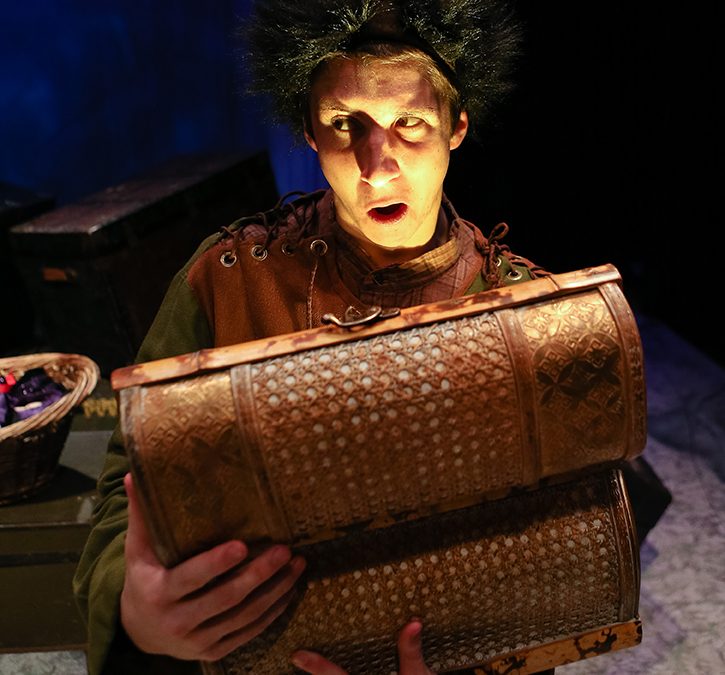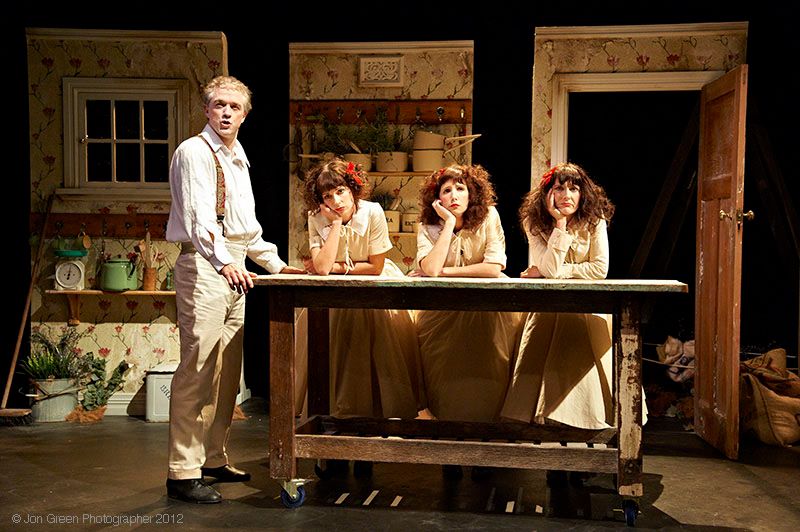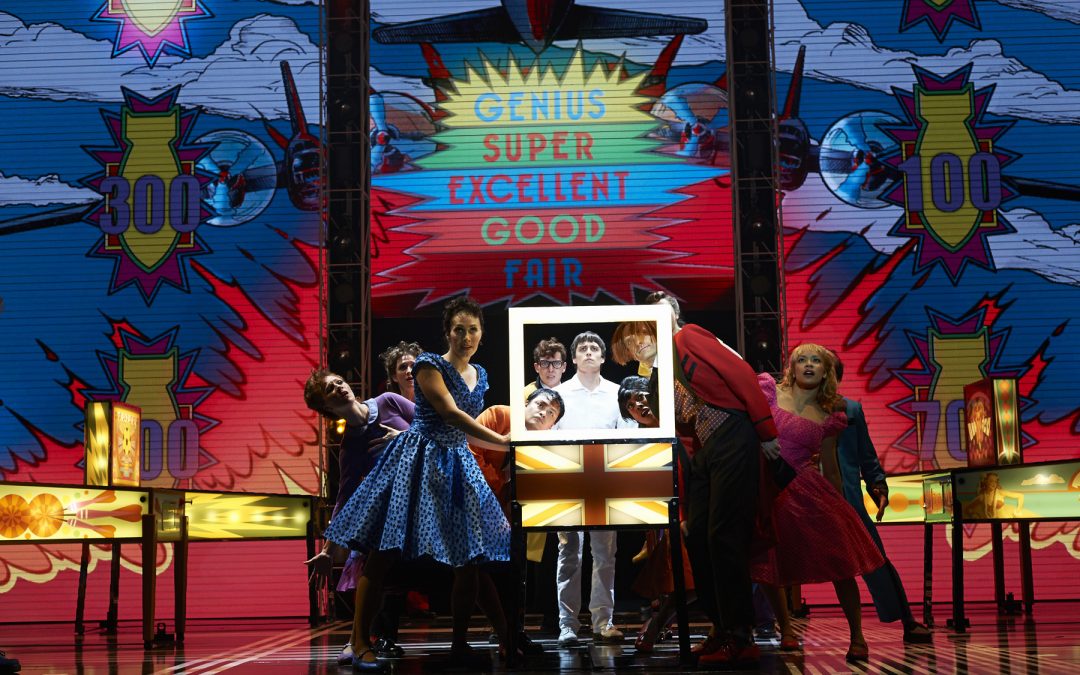
by boss | Dec 31, 2013
From Furman University –
In a recent production of Shakespeare’s The Winter’s Tale, our design team wanted to do a special effect for a particular moment in the play. The shepherd’s son discovers a fardel (package, bundle, box) abandoned on a seacoast. When he looks inside of the box he discovers that it is filled with gold coins.
The style of the play was to emphasize the fantasy and lyrical quality of the story and language. The scenic designer wondered if a golden light glow out of the fardel might create just the effect needed for that moment of the play.
He had long been interested in the wireless DMX products produced by RC4 Wireless but had not come up against a production moment that seemed to call for the use of that technology. This seemed like a perfect convergence of need and technology!
Seeing the products demonstrated in person at the Milwaukee USITT cemented the concept. The department purchased an RC4Magic Series 2 DMXio (transmitter) and an RC4Magic Series 2 DMX4dim 4-channel wireless dimmer. We also bought a Baxter Controls Pocket Console DMX to both allow for future light lab experiments and demonstrations of the capabilities of the equipment. We would also run the effect for the show out of the pocket console.
It was determined that a single MR16 DC lamp with a golden gel would serve to create the glow of the gold in the fardel. The technical director acquired the gel cell, rechargable 12V battery, lamp and other necessary cables and clamps.
It seemed necessary to have the “works” removed from the fardel because of a particularly active bit of stage business with the fardel in the second act and to reduce the weight. The technical director devised a wooden “sled” for the battery, lamp and dimmer module which fit down in a manufactured recess in the base of the fardel box. The removable module also facilitated the ease of attaching the recharge cables between performances.
The pictures show the inside of the fardel, the “sled” of components for the lighting effect and the stage picture from the moment in the play when the gold was discovered.
The resulting effect was quite magical, surprising and very effective in making that particular moment in The Winter’s Tale memorable – thanks to the beautifully designed compact equipment from RC4 Wireless.

by boss | Dec 31, 2013
Here are a few photos of one of the shows I have designed this year, a show for young people called:
THIS GIRL LAUGHED, THIS GIRL CRIED, THIS GIRL DID NOTHING by Finegan Kruckemeyer
We had a couple of set items that we lit up, they were always rolling around the stage and so needed to be wireless. We achieved everything we needed using the RC4Magic Series 2 DMX4dim and DMX2dim.
The sink lit up from inside just for a special effect really, and for a stylized moment where the character was looking into the ocean to see her bloodied reflection after a huge war.
We also lit up the dials on the Oven, and with some cutouts in the top gave the impression that the hotplates were burning red hot. We made cues where the dials would almost snap on, and the burners would slowly fade in for some authenticity, the fades were superb.
We also made a “skyscraper” effect on the back of the Oven, with some LED strings.
Directed by Noel Jordan
Set & Costume design by Alicia Clements
Lighting design by Trent Suidgeest
Produced by Barking Gecko Theatre Company, Perth, Western Australia
Production photos by Jon Green
Cheers,
Trent Suidgeest

by boss | Dec 23, 2013
Pinball machines are candy to the senses for those of us who love things that light up, make lots of noise, and have a soft spot for the arcade. While most may view these pieces of machinery as something nostalgic from the solid-state electronics era of the 1970’s, the pinball machine takes the stage front and center in the Stratford Shakespeare Festival’s production of The Who’s Tommy. And, these aren’t just any pinball machines. Through the magic of RC4Magic Wireless Dimmers and their ability to smoothly deliver dimming power to lamps, LEDs, relays, and solenoids, these pinball machines light up, flash, and chase, all while being completely untethered.
Originally created and produced back in 1992, the stage version of The Who’s Tommy concept album from 1969 became a collaborative endeavor between songwriter Pete Townshend and director Des McAnuff. The original production packed a punch that without a doubt wowed it’s audiences. It’s been twenty years since the multi Tony award winning Broadway production, and Stratford Festival brought Tommy, along with McAnuff, back as part of its Disability, Disillusion and Self-Discovery Theme of the 2013 season.
This 20th anniversary edition of Tommy involved the entirety of the original design staff except for the late Chris Perry, who was the original lighting designer. McAnuff asked Broadway designer Howell Binkley to join the artistic team as this version’s lighting designer. The production also added Stratford regular Sean Nieuwenhuis and his video designing talents.
McAnuff wanted to enhance the Tommy experience with advanced visual technologies that were non-existent twenty years ago, with brighter colors, larger contrasts, moving beams of light, and wild effects.
The Stratford Festival is a fully functional repertory theater. Each theater can expect to run two to four different productions at the same time over the course of the season. This style of ‘rep’ demands a very short changeover period. And, in the case of Tommy, the crews had an hour to change that show out and bring in either Blithe Spirit or Othello – two shows that are not so small themselves.
In order to accomplish McAnuff’s vision, the Stratford team turned to the use of RC4Magic Wireless Dimming. This technology allowed pinball machines and other scenery to fly, roll, and rotate without the worry of a nest of cables crisscrossing on and off the stage, as well as making the show a logistical possibility when considering the changeover needs. Stratford’s lighting department has a history of very positive experiences with RC4 Wireless, and it seemed fitting to continue using dependable time-proven gear with the DC low voltage light sources required in Tommy.
There was a purposeful decision to use LED lighting within the pinball machines and other set practicals. LED’s are bright and rich color emitters, which satisfied the new demands from the artistic team of brighter colors and greater contrast. Equally important, from a technical standpoint, their compact footprint along with low voltage power consumption would allow everything to stay contained within each scenic unit. RC4 Wireless dimmers allow very smooth dimming of low voltage devices and was crucial to the success of the pinball machine. Greg Bride, Stratford master electrician, explains why:
“In the Pinball machines we have done something unique. RC4 provides different output modes for LEDs, standard incandescent dimming, and non-dim triggers. We use them all. In fact, a couple of years ago we sent samples to Jim [James Smith, president and chief designer at RC4] to improve the “slow dimming” in the PWM (pulse-width-modulation) and ISL (inverse-square-law) curve so that we could get as smooth of a dim curve as possible from an LED source.”
In addition, RC4 Wireless dimmers accept a wide range of input (6-30v for the high output model, 6-24v for other models), which allowed Greg and the other Stratford electricians to select what sources worked best for the production and not be tied down to one particular voltage.
So what did the team end up with? Only about 755 total feet of LED tape light, and a combination of 264 other LED lamps, diode discs, and strobes. That’s a lot of low voltage light to control and certainly not a project for the faint of heart electrician. The Stratford team used multiple combinations of RC4 DMX4dim 4-Channel, DMX4dim-500 High Power 4-Channel, and DMX2dim 2-Channel wireless dimmers to control it all.
Watch for more information in the January 2014 issue of Lighting and Sound America magazine, including a detailed equipment list.
[pexyoutube pex_attr_src=”http://www.youtube.com/watch?v=_RMsduHt_EU”][/pexyoutube]
[pexyoutube pex_attr_src=”http://www.youtube.com/watch?v=CeTG-H8tVrU”][/pexyoutube]


